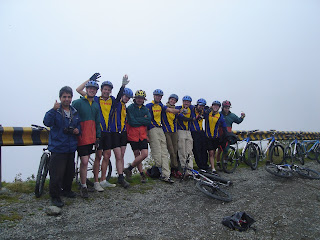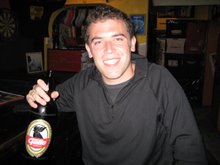At 8am Friday morning (after partying with locals the night before) I left the relative comfort of San Pedro for a three day tour through the Bolivian desert in a Toyota Land Cruiser with a company called Pamela Tours (one of 5-10 companies who run exactly the same route).
Inauspicious BeginningsThe trip did not start out well. Our group gathered and headed straight for the Bolivian border, where, in order to exit Chile, we were instructed to procure a small slip of paper we were given when we entered. Said piece of paper was, of course, in the bag that was stolen in Valpo.
Having passed that hurdle, we headed to the Bolivian entrance point to change cars. That´s when it became clear that it would be quite cold for the rest of the trip due to the altitude. I changed out of the shorts I had worn (thinking: desert + daytime = hot).
Here´s a picture of the border checkpoint. It reminded me of that scene in Blazing Saddles where they put toll boths in the middle of the desert to stop the bad guys from coming into town.

We then began our ascent, eventually reaching 4000 meters above sea level. Not having realized we´d be going so high, I was ill prepared. I drank too much alcohol the night before and hadn´t popped any altitude pills. I began to feel downright shitty.
At our first scenic stop, it became disheartenly clear that the picture above would be the last I would take on this trip. When I turned on my brand new camera, it said "lens error, restart camera," and promptly shut off. Of course, the manual featured no instructions on how to ¨restart¨the camera (powering it down and removing the battery did not do the trick).
This combination of events constituted a first-rate assault on my will. I was not excited to be "roughing it" in the Bolivian desert at this point. My mood was not lightened when I found out that our refugio for the night had electricity for only two hours, no hot water and no heat. In late afternoon I was freezing under three blankets. This did not portend well for ¨la noche.¨
Team T-Bone´s Frogos and A Turn for the Good
Things began looking up later that day. I laid down and felt a bit better. And, the more I hung out with my car-mates, the more fun I started having.
Our crew consisted of four Americans (really United States-ers because everyone who lives down here is also an American; but we don´t really have that term, so I reluctantly use American even though it´s not the ¨prefered nomenclature¨as Walter would say in the Big Lebowski) and two French guys. This combination was later described by a British guy we were beating at drinking games as ¨the two worst nationalities.¨ We were all between 23 and 30--with me, of course, dragging up the average age a bit. Along with yours truly, the Americans were:
Chris--a collegiate cycler and triathelete who studied vitaculture and plans to open a vineyard on his family´s farm in northern California.
Dennis--a UMass-Amherst grad from Boston who loves the Socks and the Dead.
Natalie--a Californian who went to school in Seattle, has a boyfriend in London, and handled her role as ¨la unica chica¨in the car admirably (she may have even enjoyed it, but you´d have to ask her).
The two French guys were a hilarious tandem of business students. Thibault (pronouced Tibo, but which I quickly changed to T-Bone) is a virtual encylopedia of knowledge about subjects ranging from European history to the Tour de France and the NBA. Francois exudes an obvious and contagious lust for life, has thought deeply about subjects ranging from philosophy to World War II, and has only two speeds--full speed and sleeping.
Everyone was really looking out for each other. From pooling resources (Cocao leaves for helping with the altitude, water, etc.) to letting me switch my chip into folks' cameras so I could have at least a few pictures, we really became a team.
The night wasn't even that cold.

Second day was fun. When we left the refugio, we were joined by a woman and her (as you can see to the right) adorable young son. He started out extremely entertaining, but sometime around the 8th hour he became quite annoying.
But the night was even better. We stayed in a hotel made of salt, had a nice dinner of llama meat and ended up playing flip cup against a bunch of British folks for the rest of the night. Everyone played. We even came up with a team name, T-Bone's Frogos (frogo is a combination of frogs and gringos).
Unfortunately, I don't have very many pictures of any of this yet, but will have to update this section when everyone sends their pictures around.
Sunrise at Inca IslandThe next morning, after we all drank a fair bit the night before, we got up at 5am to catch sunrise at Inca Island. We almost missed it because at the appointed hour, our guide was nowhere to be found. I wanted to go back to sleep, but Francois would have none of it; and Dennis wandered the halls of the hotel yelling our guide's name and generally waking up the whole place.
It was well worth it. Inca Island is an island of cactus and other vegetation in the middle of a lake of salt. It is beautiful, and sunrise was a great time to be there. And, you can take cool perspective shots on the salt flats. Here are some of the pics I took with other folks' cameras:



We finished up our trip in Uyuni, a small desert town in Bolivia without much going on. We kept the team together for one last night--well, almost. Chris had to turn around and head back to San Pedro after lunch to ultimately catch a flight back to CA. Tibo and Francois left at 3am to continue their journey. Dennis and I got a bus to La Paz the next evening. And, Natalie stuck around waiting for a friend who was stuck in La Paz without her luggage.
When we arrived in Uyuni, Chris and I had quite an adventure trying to pay for the trip. Chris had paid half in San Pedro. The guy there had told me I could pay in Uyuni by credit card, no problem. Well, the problem was it was Sunday. They weren't able to accept a credit card payment and the ATMs were literally closed. After refusing to leave my passport (I had it stolen once, I wasn't going to part with it again) and driving around town for a while, we finally found a place that would accept our credit card. Ironically, the ATMs opened a few hours later.
Because of this last glitch (clearly poor planning on the operators part, yet they acted as if it was our fault) and the fact that our drivers were simply that--they didn't offer much in terms of guidance--I wouldn't give Pamela Tours a glowing recommendation. The trip, however, was well worth the $80 I paid for two nights, three days, and transport to Bolivia. There were some amazing sights along the way, but I feel incredibly lucky because the people on this trip and the team dynamic that emerged made it a highlight of my adventure.



 Here's "arroz con leche," rice with milk served sweet and hot.
Here's "arroz con leche," rice with milk served sweet and hot. 














































